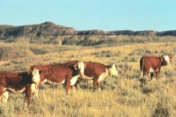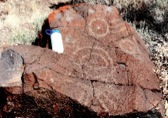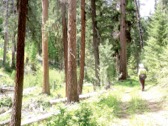Less Traveled Northwest
Day Hikes for the Adventurous
Issues Related to Backcountry Day Hiking
Will Cows be Encountered on These Hikes?
Perhaps. Nothing spoils a day hike quicker than finding a concentration of cows in a remote stream canyon, where the banks are trampled, the vegetation is denuded and cow pies line the trail for miles. Though we’ve encountered this scene at times, it hasn’t been very often. Cows are usually present to some degree in every corner of federal lands during the summer months. But if their numbers are not overwhelming, and they are not concentrated in sensitive habitats, their impacts for the day hiker are usually easy to ignore.
How about Archaeological Sites?
Especially in Southeast Oregon, it’s not uncommon to run across Native American petroglyphs, pictographs, obsidian chips or rock shelters. However, in our hike descriptions, we avoid drawing attention to these sites. This seems the best policy, due to the extensive vandalism and looting at archaeological sites in the inland Northwest.
A series of laws passed in the twentieth century forbids the taking of Native American artifacts from federal land (including National Forest and BLM lands). In short: Unless issued a permit for scientific research, it is illegal to collect any artifacts, ancient or historical, on federal lands. This includes arrowheads, obsidian chips, pot shards, old bottles or pieces of old buildings.
Won’t Publicizing These Hikes Lead to Their Overuse?
Based on the few backcountry trailhead registers we’ve seen, even if the number of visitors doubled on many of these day hikes, the total annual usage would still be less than 30 trips per year. Over the 16-week hiking season from June through September, this works out to less than 2 trips per week — which is still far from overused.
It’s also a fallacy, we believe, that the only way to conserve these wild, remote public lands is to keep them a secret. In fact, because they are already managed for multiple uses (including grazing, logging and mining), we feel the best way to preserve them is to build on the constituency of recreational users who love them, who use them, and who will advocate for their continued protection.
Recommended Reading
Backcountry Travel
Wilderness Navigation, Bob Burns and Mike Burns
Wilderness 911, Eric Weiss, M.D.
Boondock RVing: Camping Off the Beaten Path, Bill and Jan Moeller
Pacific Northwest
Weather of the Pacific Northwest, Cliff Mass.
The Restless Northwest: A Geologic History, Hill Williams
Natural Vegetation of Oregon and Washington, Jerry Franklin and C.T. Dyrness
Atlas of the Pacific Northwest, edited by Philip Jackson and Jon Kimerling
Page last updated: 12/17/11



